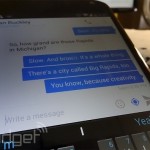You might consider volcanic activity an efficient way of destroying living tissues, but volcanic glasses are often used to study early life. Certain microbial corrosion textures in volcanic glass and in Cenozoic seafloor basalts have been interpreted as evidence of a deep biosphere, dating back to the earliest periods of life on Earth. Similarly, textures found in volcanic glass from the Barberton Greenstone Belt in South Africa and the Pilbara Craton in Australia also suggest the presence of a deep oceanic biosphere on Earth as early as 3.35 billion years ago. But a group of researchers had challenged the idea that these traces resulted from biological activity. Now, in a strong response, another group has defended the interpretation. We seem to have a genuine scientific controversy on our hands. Is this life? Volcanic glass from Cenozoic seafloor volcanics sometimes contain what are called “biotextures.” These typically take on two major forms, either microscopic spherical cavities or tubules that extend into the volcanic glass. Biogenicity, substances produced by life processes, is the most widely accepted explanation for these features. These textures can provide us with valuable information about the types of microorganisms that existed long ago, and shed light on biological processes and how those processes may have evolved over time. Read 11 remaining paragraphs | Comments
View article:
Could remnants of the earliest life be preserved in volcanic glass?






